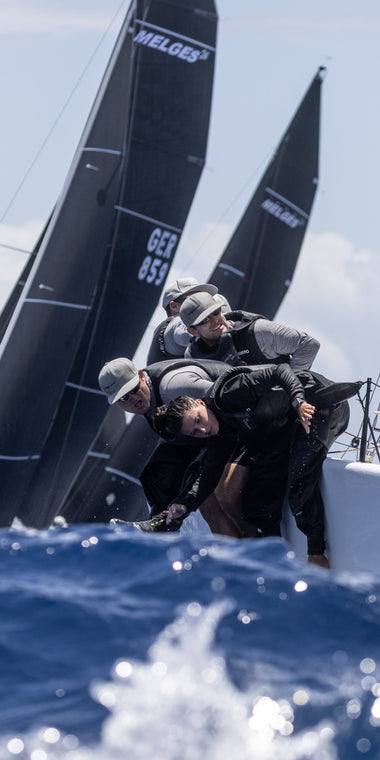MELGES IC37 TIPS: VOLUME ONE
MELGES IC37 TIPS: VOLUME ONE
Racing Season Begins With Training Weekend In Newport, RI

A historic weekend in Newport with nineteen brand new IC37s sailing together for the first time ever, in fantastic weather conditions paired with a fun and educational environment. All teams were eager to learn and sail the new boats. North Sails and North U presented a full-weekend clinic and coaching session, sharing their expertise to kick-start this amazing new fleet with the potential to be one of the most fun one design summers ever for the New York Yacht Club.
North experts Tim Healy, Kimo Worthington and IC37 sail designer Mike Marshall, with the help of North U’s Bill Gladstone compiled a series of tips and takeaways from the training session to share with the teams in preparation for the Leukemia Cup.

Consistent Spinnaker Takedowns
For both windward side and leeward side takedowns, time the drop with a decisive turn down to unload the spin. Timing and positioning is everything.
Approaching the leeward mark: The Bow Team & Pit
Just prior to the start of the takedown, save time and speed up the maneuver by preloading the takedown/retriever line. No slack should be present once the maneuver initiates. At this time the sheet gets released and overhauled, take down line gets hauled down and halyard comes off. The lead bow person can assist the retriever line by also pulling down and focus on getting the middle-foot of the kite up to keep the tack inside the lifelines. The second crew assists with the middle of the kite to the clew, making sure no cloth is over the lifelines. If you divide up the foot, and keep pulling until you reach the corners, the kite shouldn’t ever be in the water. The tack is released with the pole at the same time after foot is in control and on deck or in the hatch. The tack line is then pulled into hatch until the knot stops at the clutch and the pole is pulled in. If it happens at the same time, the tack release will help bring the pole-in, and the tack will be the last corner inside the hatch. This is a good place to start for consistent takedowns. We are sure as teams get more time with the boats this will get refined.
As the wind picks up, start the takedown process earlier and be careful not to overstand the gate marks. It is much better to soak a bit into the marks than it is to be coming in hot with no wiggle room and sail past the marks. You will find in big breeze, a conservative take down will almost always gain a point or two at each leeward gate. Understand your crew strengths from the mast forward and set them up for a successful mark rounding. Depending on the takedown, they may need more time.

Leeward Mark Approach
- When it’s breezy aim for the middle of the gates so you so can round either mark and give yourself room for the drop. It’s a big loss to overstand the gates.
- Ease the vang downwind in bow up mode. The traveler should be all the way to leeward and just use the mainsheet for leech tension. A loose vang will reduce helm so driver can go bow up in order to get to the proper heel angle and to reach the target speed. As speed builds, apparent wind will go forward and VMG will increase.
- Backstay on downwind in overpowering conditions (15+knots). This will keep mast aft in order to keep the luff of the spin tight, keeping draft forward and exit straight for better heavy air, bow up, shape. Backstay on will also flatten the main so the boat will not trip up in a big puff or crashing into a wave. Remember: Release old backstay in a Jibe! Not releasing will be a guaranteed broach in big breeze.
- When it comes to managing the upwind layline, it’s better to overstand a little than to tack shy of the layline and be forced to gybe out. Remember an IC37 accelerates over boats that are pinching and going slow trying to make the mark. You can use this to your advantage.
Achieving The Correct Upwind Sail Settings
Your outhaul should be max in over 12 kts. Also, a little vang in heavy air helps flatten the bottom of the main. When it comes to your upwind heel angle and sail shapes, the IC37 is optimized at 18-20 degrees of heel.
The goal with your sail setup is to create as much power as possible to achieve that heel. This involves keeping the runner eased, the main sheet trimmed so the number-two batten is just open, and the traveler is high. For the jib set up, the halyard should be on the loose side and the lead set for a powerful foot. The sheet should be trimmed so the mid-leech is just closing. Once you have achieved the correct upwind heel angle, you do everything that you can to get the bow down, and the boat moving faster so that the keel starts generating lift. This will give you the ability to point. Opposite to trying to achieve heel, trying to achieve speed involves making the sail plan rapidly flatter to reduce drag.

Steps To Achieve Speed and Reduce Drag
- Increasing shims and backstay tensions
- Easing the mainsheet
- Moving the jib lead out and flattening the jib foot
Think of the boat as having two power levels, and not a linear power increase. One level is where you are looking for heel. The second level is where you have all the heel you need, and are translating the surplus power into speed.
Go to the North Sails IC37 Tuning Guide for detailed and up to date tuning information.































